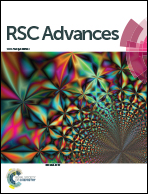In situ synthesis of N-doped carbon nanotubes–BiOCl nanocomposites and their synergistic photocatalytic performance†
Abstract
N-Doped carbon nanotube–BiOCl (NCB) nanocomposites were prepared by an in situ growth strategy in liquid ethylene glycol (EG). The prepared samples were characterized by powder X-ray diffraction (XRD), field-emission scanning electron microscopy (FESEM), transmission electron microscopy (TEM), X-ray photoelectron spectroscopy (XPS), UV-vis diffuse reflectance spectroscopy (DRS), and photoluminescence (PL) emission spectroscopy. The photocatalytic investigations showed that the 2-NCB nanocomposites loaded with 2.0 wt% N-doped carbon nanotubes (CNxNTs) possessed the highest rate constant, which is about 2.5, 3.7, and 1.5 times that of pure BiOCl 3D hierarchical structures, BiOCl/MWCNTs composites, and P25, respectively. The enhanced photocatalytic performance could be attributed to the beneficial microstructure, synergistic effects of coupled CNxNTs–BiOCl nanocomposites, and the high migration efficiency of the photogenerated electrons, which may effectively suppress the charge recombination.


 Please wait while we load your content...
Please wait while we load your content...